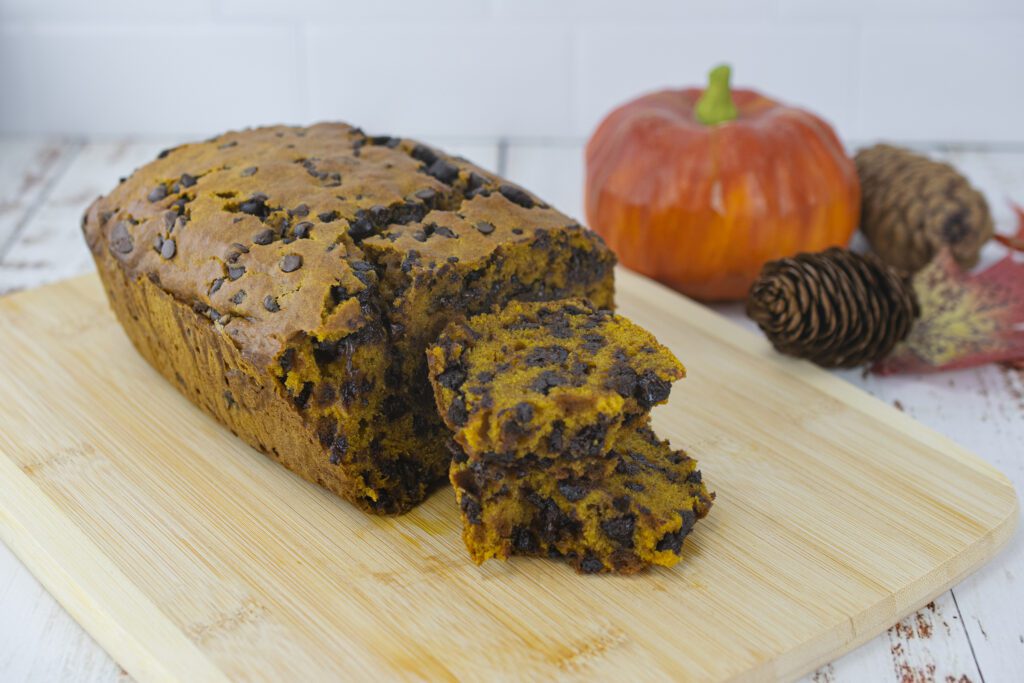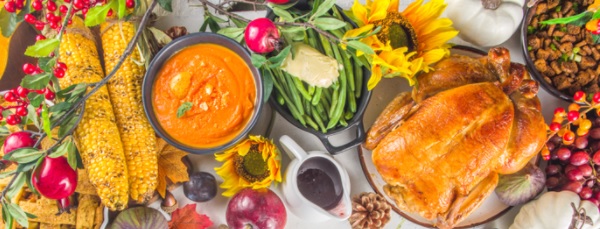Don’t Wing Portion Control of Thanksgiving Staples
When using traditional recipes containing creams and added sugars, opt for smaller portions to allow ample plate space for healthier fare. For example, you’ll sacrifice fat (not flavor and creaminess) when using low-fat buttermilk or low-sodium chicken stock in place of cream or whole milk in mashed potatoes, sweet potatoes or butternut squash. Maybe try working in mashed cauliflower into mashed potatoes for a lighter bite.
And, of course, there’s no rule that all Thanksgiving staples have be served in mashed or casserole form. A more whole and less-processed form might be gobbled up at your table just the same. This also applies to green beans. You could smother them with a can of thick, mushroom soup as usual, but maybe you should toss them in a light citrus vinaigrette instead.

Color Code Your Thanksgiving Staples
Ever notice that many Thanksgiving staples are sort of bland in color and, well, served mushy? As with any meal, create a food rainbow comprised of vibrant colors. Perhaps that means less brown gravy… and more cranberry (red), sweet potato (orange), squash (yellow), beans/sprouts (green) and purple carrots (blue/purple). Eating diverse, nutrient-packed produce helps to control weight, blood pressure and the risk of heart disease and cancer; while combating post-meal guilt.
Thanksgiving Staples to Celebrate Year-Round
- Turkey is a great source of protein because it’s leaner than most red meat and even chicken. A 3-ounce portion of roasted skinless turkey breast contains only 3 grams of fat and is naturally low in sodium, containing less than 25 milligrams per ounce, according to the National Federation of Turkeys. You may only roast a whole bird once a year, but turkey (ground, sliced, etc.) should remain a go-to staple.
- Sweet potatoes boast vitamin A, vitamin C, potassium and fiber that can make a tasty side dish or dessert. Rather than serving casserole-style using heavy cream and sugary marshmallows, explore ingredients like ginger, orange zest, cinnamon and a pinch of brown sugar. Year-round, sweet potatoes are yummy as French fries, veggie oodles, basic roasted (or microwaved) and in pancake batter.
- Canned cranberry sauce is loaded with sugar, but homemade chutneys work on holidays and year-round — from topping turkey to toast (like a jam). Smash fresh cranberries and combine with apple or orange juice, honey or white balsamic vinegar to achieve desired sweetness. Like other berries, antioxidant-rich cranberries aid the body’s digestive health and promote good heart-health, even possibly improving blood pressure, cholesterol and lowered risk of cancer. If dried cranberries are your go-to for salad toppings or baking, note that one cup of chopped raw cranberries contains 14.6 milligrams of vitamin C per serving, while one cup of dried cranberries contains 0.3 milligrams.

- Butternut squash, according to UF/IFAS Extension, has an impressive nutrition profile containing vitamin A, vitamin C, fiber and phytochemicals. It provides 582 milligrams of potassium in one serving which is better than the 422 milligrams found in a banana. Butternut squash is delicious in multiple forms, including soups and stews. If you have a picky eater, puree butternut squash to sneak into tomato sauce for pasta dishes.
- Brussels sprouts are a good source of vitamins C and K, folate, carotenoids and fiber. Forgo the artery-clogging bacon bits and, instead, top with brain-boosting walnuts or pine nuts, tossed with olive oil, apple cider vinegar and a bit of salt. While this vegetable omits a strong smell when cooked, it surely can maintain a strong body year-round.
- Pumpkin is low in fat and calories, and loaded with potassium, vitamin A and vitamin C. Using a low-sugar recipe, make pumpkin pies with canned, evaporated fat-free milk, a graham cracker crust and light or fat-free whipped topping. Keep a can in your pantry to whip into muffins or breads beyond the fall season. Of course, you can swap out decadent Thanksgiving pies for baked apples or poached pears.
- Bread is the star of traditional stuffing but recipes using cornbread are better as corn meal is a whole grain. Lighten the dish with onions, celery, carrots and apples, rather than using fatty sausage.
- Gravy can be less greasy if you use a fat separator or refrigerate the pan juices and skim the fat off before making gravy.

Game Day Strategy for Thanksgiving
Plan to come to the Thanksgiving table hungry, but not starving. If you skip breakfast or lunch, your famished state may lead to overindulgence. Have a sensible breakfast, like yogurt and fruit, and light lunch, like salad or a broth-based soup. And don’t fill up on heavy appetizers or go crazy on holiday drink refills.
Finally, after your Thanksgiving meal, it’s time to shake a tail feather! Research by the American Heart Association shows that you can gain about two hours of life expectancy for every hour of regular, vigorous exercise that you do. That’s a great 2-4-1 deal. Once you’ve fueled your body with healthier holiday selections, hit the pavement for a walk. Bonus points for briskly wobbling like a turkey! And football fans can use half-times for post-turkey pigskin scrimmages in the yard too.
Why this Nutritional Guidance is Needed, Especially within the Disability Community
Obesity is a major health concern in our country; and, unfortunately, some people with disabilities are at a greater risk of obesity. Here are some alarming statistics:
- Children and adults with mobility limitations and intellectual or learning disabilities are at greatest risk for obesity.
- 20% of children 10 through 17 years of age who have special health care needs are obese compared with 15% of children of the same ages without special health care needs.
- Annual health care costs of obesity that are related to disability are estimated at approximately $44 billion.
What Can Be Done?
Obesity is a complex problem that requires a strong call for action, at many levels, for both adults as well as children. Just educating yourself with this article is a great step, and especially if you take these tips to heart.
Also try to:
- Eat more fruits and vegetables and fewer foods high in fat and sugar.
- Drink more water instead of sugary drinks.
- Watch less television.
- Be more physically active.
Evidence shows that regular physical activity provides important health benefits for people with disabilities. Benefits include improved cardiovascular and muscle fitness, mental health, balance and a better ability to do tasks of daily life.
Happy Thanksgiving and Happy Holidays!

Like this content? Also check out:
A portion of this article was originally published by Natural Awakenings.






